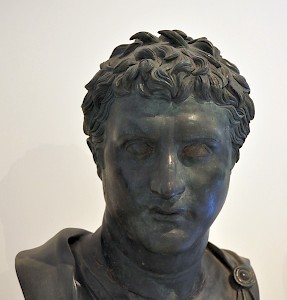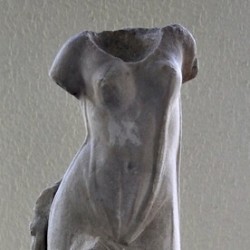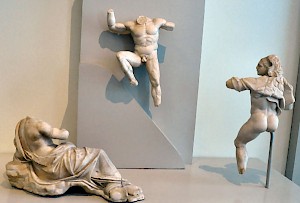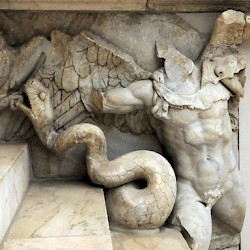Pergamon (2)
Q18986Pergamon (Greek: τὸ Πέργαμον; Latin Pergamum): city in Teuthrania, famous for a sanctuary of Asclepius, important during the Hellenistic age under the Attalid dynasty. Modern Bergama.
Attalus I: Independence
When Attalus became ruler of Pergamon (241 BCE), the Galatians demanded the tribute that they had come to expect from Eumenes. This time, however, it was refused.note War broke out, and Eumenes was victorious. He was not the first to defeat the Galatians, but it was still an impressive achievement, and he accepted the royal title,note together with the surname Soter, "savior".
More successes were to come. In the next year, civil war broke out in the Seleucid Empire, where king Seleucus II Callinicus was challenged by Antiochus Hierax, who was in control of large parts of Asia Minor, and managed to stand his ground when Seleucus tried to reunite the Seleucid territories. In the end, Pergamon benefited: Attalus' army, which had overcome the Galatians, was not afraid of Hierax and defeated him. Attalus' zone of influence now extended to the Taurus Mountains.
Artists were invited to celebrate these successes. Several statues were erected, like the famous "Dying Gaul" and the "Galatian Suicide". (Both statues would later be transported to Rome and were placed in the Gardens of Caesar.) An interesting innovation was the "Pergamene Capital", a type of capital that was neither Doric, Ionic, or Corinthian, but was a completely new design. It is as if the architects wanted to say that the age of Sparta, Athens, and Corinth had come to an end. Pergamon was to be the new champion of hellenism - philosophers, sculptors, architects, soldiers: the city had everything.
 Attalus I Soter |
 Rome, Gardens of Caesar, The Dying Gaul |
 Rome, Gardens of Caesar, The Galatian Suicide |
 Pergamene capital |
Meanwhile, the Seleucid Empire was not willing to admit that it had lost Asia Minor. After he had succeeded his father Seleucus II Callinicus in 225, Seleucus III Keraunos tried to recover what had been lost. His general, a man named Achaeus, had some succes, but the Pergamenes were lucky. The new Seleucid king died and 222 and Achaeus revolted, while the next king, Antiochus III the Great, was more interested in an attack on Egypt's Asian possessions (the Fourth Syrian War). Joining forces with the Galatians, Eumenes reduced Achaeus, and in 216, he allied himself to Antiochus III, who put an end to Achaeus' revolt. Pergamum had lost territory, but it might have been a lot worse.

After this, there was a crisis in the West, where Pergamon had allied itself to the Aetolian League, which in 211 sided in the First Macedonian War (214-205) with Rome in its war against king Philip V of Macedonia. For King Attalus, this meant some inconclusive naval fighting in the western part of the Aegean Sea and the acquisition of the isle of Aegina, but the main consequence was that for the first time, Pergamon had been allied to Rome. This friendship, although it had its ups and downs, was to remain intact until in 133, king Attalus III would bequeathe his realm to the Romans. One of the most remarkable collaborations was the transfer of the black stone that was venerated in the temple of the Great Mother in Pessinus to Rome in 204.note

It's an odd story, because we know that in this age, there was also an interest in the cult of the Great Mother in Pergamon itself: king Attalus built a new temple to Cybele on the southern slope of the citadel. We would not have expected the most venerable cult object to be given away. Anyhow, it was not the only monument built at this moment: Attalus also ordered the construction of a market building and a temple of Zeus, both on the citadel, and expanded the temple of Demeter on the south slope. In Delphi, the king displayed his power and wealth by building a stoa.
The final years of Attalus' reign saw renewed war. Macedonia tried to expand its powers in the Aegean Sea, and threatened the interests of Pergamon, Rhodes, and Athens. War broke out and although a naval battle of Chios remained unconcluded, Pergamon was attacked - the temple of Asclepius was looted, although the Macedonians refrained from attacking the citadel itself. In 201, Attalus asked the Roman Senate to intervene, and indeed, Rome came to help the Greek allies: the Second Macedonian War, which ended in the crushing defeat of Macedonia in the Battle of Cynoscephalae (197). This was more or less at the moment when Attalus died and left power to his son Eumenes II.
Eumenes II: Splendor

After the end of the Second Macedonian War, Rome had created a power vacuum in Greece by declaring its cities free and independent. As could be (and probably was) expected, the Greek cities started to fight, and invited foreign powers. The bait was too tempting for the Seleucid king Antiochus III the Great, who swallowed it, and realized too late that he and his army were entering a theater of operations that was perfectly suited to the Romans, who had a good reputation and knew the scene.
The Syrian War lasted from 192 to 188. Just like his father in the two Macedonian Wars, Eumenes supported the Romans, for example when they needed to cross the Hellespont after they had expelled Antiochus from Greece. In the Battle of Magnesia, in 189, the allies defeated the Seleucid troops again, and added a campaign against the Galatians. The Peace of Apamea was Pergamon’s reward: Rome forced the Seleucids to hand over large parts of Asia Minor, including Ephesus, Telmessus, and Tralles, and all land west of the Taurus.note
Eumenes now tried to expand his realm. In 183, he waged war against Prusias I the Lame of Bithynia, and although he was defeated, Roman support gave him the final victory. Other successes were territorial gains in Pontus, an alliance with the towns of Crete, and the succession of Antiochus IV Epiphanes in the Seleucid Empire.
The city now was one of the main centers of Greek culture. A library had been founded that was to have 200,000 volumes: a serious rival for the library of Alexandria. There’s a story, probably apocryphal, that Egyptian forbade the export of papyrus to make sure that the Pergamenes could not add new scrolls, forcing them to make their books on parchment, which is more expensive (but lasts longer). Some of the sculpture related to this library showed that Pergamon deliberately tried to copy Athens.
 Pergamene copy of the Alcamenes herm |
 Pergamon, Copy of Phidias' Athena |
 Pergamon, Statue of a dancer |
 Pergamon, Temple of Athena, Propylaea |
Other new buildings were a four kilometer long second wall, which now included the southern slope of the citadel and the land to the southwest, towards the small river Selinus (a contributary of the river Caicus). On the citadel itself, the terrace walls were improved and an arsenal was built. The old temple of Zeus on the citadel was replaced by the "upper agora", while a "lower agora" was built on the south slope, together with housed and a gymnasium. On the steep western slope, a theater was built, together with a temple of Dionysius.
 Pergamon, Theater |
 Pergamon, Arsenal |
 Pergamon, Temple of Dionysus |
 Pergamon, Terrace wall |
In 172, King Eumenes visited Rome, where he warned the Senate that Macedonia was again preparing for war. On his way home, when the Pergamene ruler wanted to visit Delphi, there was an assassination attempt. The report that the Macedonians had killed a king confirmed all suspicions about Macedonia and war broke out: Rome attacked the once powerful kingdom. This Third Macedonian War lasted from 171 to 168 and was the end of Macedonia.

It is likely that Eumenes, who had survived the attack but let no one know that he was recovering in Aegina, deliberately laid low, to make sure that Macedonia would indeed be attacked. Even his bother Attalus and his wife Stratonice were unaware of his survival: Attalus “put on the crown, married the queen, and assumed the rule”, as Plutarch describes the crisis.note After war had been declared, Eumenes returned to his city, where the marriage between Stratonice and Attalus was dissolved and power was handed over to the original king.
Had Rome indeed been tricked into entering the war? Of course we can never know. What we do know, however, is that the Romans were displeased about the way the Pergamenes had conducted themselves in the war. When Eumenes wanted to apologize, the Romans reverted to a trick not to have to accept the excuses:
King Eumenes, who had taken an ambiguous stance during the Macedonian war, came to Rome. To prevent him appearing to be considered an enemy (if he was not permitted to enter) or acquitted (if he was admitted), a law was passed that no king could be permitted to enter Rome. note
The damage to the friendship with Rome had some influence on Pergamene policy. In 166, Eumenes waged war against the Galatians, and was victorious. The complete submission of the tribes was within sight, but Rome ordered Pergamon to allow the defeated warriors to remain independent. Nevertheless, the eastern border of Pergamon was now secured and Eumenes had good reasons for celebration. In Pergamon, the splendid monument known as the "Altar of Zeus" was built: one of the most famous examples of ancient art. The temple of Athena was also expanded after the Galatian victory.
In 159, King Eumenes II Soter died. His wife Stratonice married to his brother Attalus again. The succession was smooth, but the next ruler could no longer dream of foreign conquests.
 Pergamon Altar, Model |
 Pergamon Altar, Athena |
 Pergamon Altar, Zeus |
 Pergamon Altar, General view |
 The Pergamon Altar on a coin |
 Pergamon Altar, detail |
 Pergamon Altar, detail |
 Pergamon Altar, Foundations |